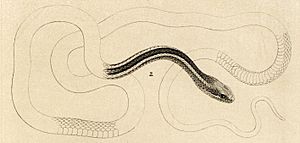Galapagos racer facts for kids
Quick facts for kids Galapagos racer |
|
|---|---|
 |
|
| Conservation status | |
| Scientific classification | |
| Genus: |
Pseudalsophis
|
| Species: |
biserialis
|
The Galápagos racer (Pseudalsophis biserialis) is a type of snake found only on the Galápagos Islands. It belongs to a group of snakes called colubrids. These snakes are mildly venomous, but they are not considered dangerous to humans. They are also constrictors, meaning they squeeze their prey to catch it.
There are two main types, or subspecies, of Galápagos racers: the eastern and western racers. The western racers are usually bigger, longer, and darker than the eastern ones. Western racers are good at hunting fish. Both types of racers also eat small reptiles, eggs, small animals like rodents, and baby birds.
Contents
What is the Galápagos Racer?
The Galápagos racer is a special snake that lives only on the Galápagos Islands. This means it is endemic to these islands. It is one of only three snake species found there. Scientists first described this snake in 1860.
Why is it Special?
In November 2016, the Galápagos racer became very famous! A video from the BBC show Planet Earth II went viral. It showed a group of these snakes hunting baby marine iguanas right after they hatched. This amazing video helped many people learn about these unique snakes.
What do Galápagos Racers Eat?
These snakes are skilled hunters. The western subspecies is known for hunting fish. Both the eastern and western racers also enjoy a diet of small reptiles, eggs, rodents (like mice and rats), and young birds that have just hatched. They use their constricting ability to catch their food.
Are Galápagos Racers in Danger?
The Galápagos racer is currently listed as "near threatened". This means it could become endangered in the future. The biggest problem for these snakes comes from introduced species. These are animals that humans brought to the islands, like pigs, rats, mice, and cats. These new animals often eat the snake eggs, which makes it harder for the Galápagos racer population to grow.
How are Galápagos Racers Named?
The scientific name for the Galápagos racer is Pseudalsophis biserialis. It was first named Herpetodryas biserialis by a scientist named Albert Günther in 1860. Over the years, scientists have changed its name several times as they learned more about it. Some of its past names include Dromicus, Orpheomorphus, and Oraphis. This process of naming and grouping living things is called taxonomy.
See also
 In Spanish: Pseudalsophis biserialis para niños
In Spanish: Pseudalsophis biserialis para niños


